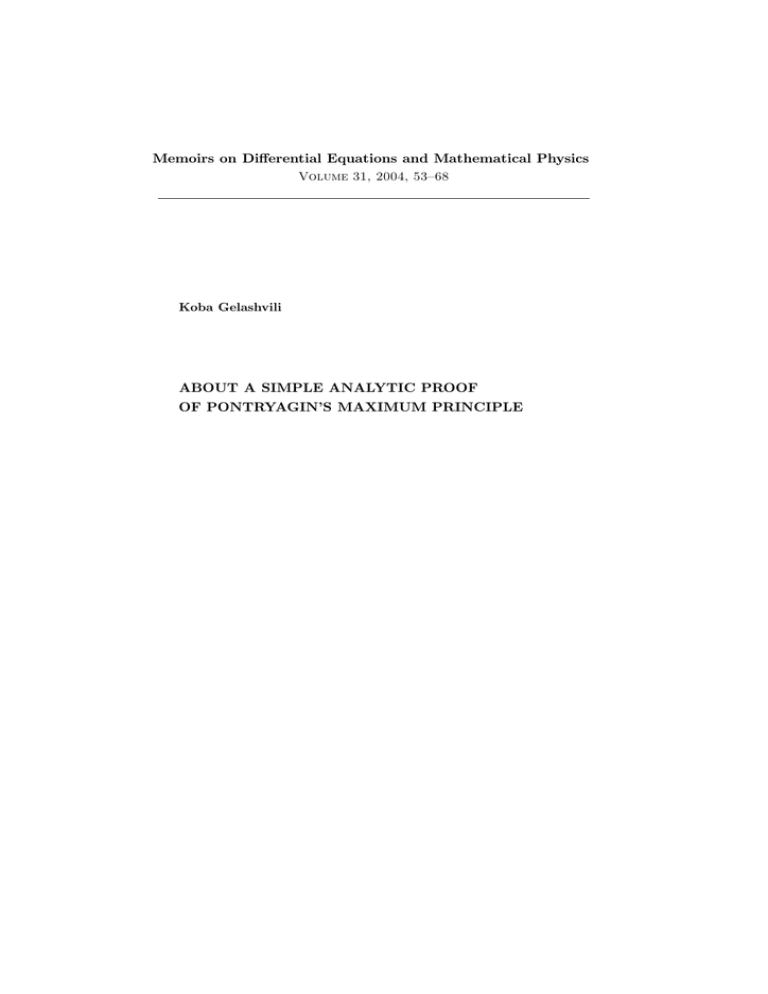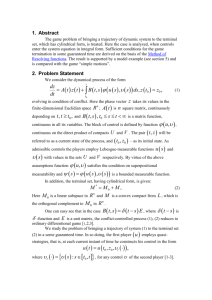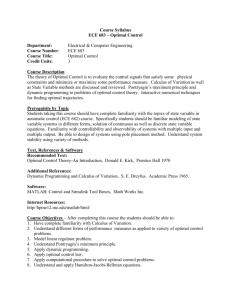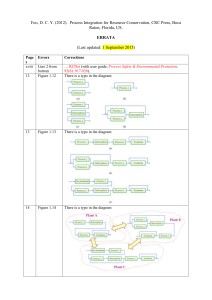Memoirs on Differential Equations and Mathematical Physics OF PONTRYAGIN’S MAXIMUM PRINCIPLE
advertisement

Memoirs on Differential Equations and Mathematical Physics
Volume 31, 2004, 53–68
Koba Gelashvili
ABOUT A SIMPLE ANALYTIC PROOF
OF PONTRYAGIN’S MAXIMUM PRINCIPLE
Abstract. Using compact expressions for optimal and varied trajectories
based on the representation of the Cauchy problem solution as evolution
system of functions of initial values, a simple analytic proof of Pontryagin’s
Maximum Principle for fixed endpoints is obtained. Some non-standard
problems of optimal control theory are considered shortly, too.
2000 Mathematics Subject Classification. 49K15.
Key words and phrases: Evolution system, Pontryagin’s Maximum
Principle, variable control area, admissible controls with uniformly limited
number of points of discontinuity.
!
#"$ %$ & '( )* + # ' ( -, "
. ,! ( + $ %-) '/ . $ !'/ 0 1 %& 2 1 1 '/
# $ 3 4!3" '/ ) # + % $ $ + 5
6 %$ 7% 74
%6 " 6 ' %$ 3 "6
5
55
PONTRYAGIN’S MAXIMUM PRINCIPLE
Statement of the problem. Pontryagin’s Maximum Principle. Usually, by Rk we denote the set of collections of k real numbers (x1 , . . . , xk ),
endowed with natural algebraic operations and Euclidean norm. For g =
(g1 , . . . , gm ) : Rk → Rm , Jacobi’s matrix at the point x = (x1 , . . . , xk ) is
denoted by
∂g1 (x)
∂g1 (x)
···
∂x1
∂xk
.. ,
..
g 0 (x) = ...
.
.
∂gm (x)
∂x1
···
∂gm (x)
∂xk
and for a vector function g = (g1 , . . . , gm ) : Rk × Rl → Rm , Jacobi’s matrix
with respect to x = (x1 , . . . , xk ) at the point (x, y) ∈ Rk × Rl is denoted by
∂g1 (x,y)
∂g1 (x,y)
···
∂x1
∂xk
∂g(x, y)
.
..
.
..
..
=
.
.
∂x
∂gm (x,y)
∂gm (x,y)
···
∂x1
∂xk
For a vector or matrix function x(t), t ∈ R, ẋ(t) denotes the componentwise derivative of x(t); for example, if x(t) = (x1 (t), . . . , xk (t)), then
ẋ(t) = (ẋ1 (t), . . . , ẋk (t)).
Let us formulate the main problem of the optimal control theory.
Let U ⊂ Rk be the control area, the functions fi (x1 , . . . , xn , u1 , . . . , uk )
∂fi
i = 0, 1, . . . , n, j = 1, . . . , n;
and ∂x
j continuously map Rn × U into R,
[t0 , t1 ] be a fixed non-trivial segment (i.e., t0 < t1 ); Ω be the set of admissible
controls consisting the functions u(t) = (u1 (t), . . . , uk (t)) such that u(·) :
[t0 , t1 ] → U is continuous from the left, continuous at the points t0 , t1 , and
u(·) can have but a finite number of points of discontinuity, and all these
points must be of the first kind.
Q
Let (x10 , . . . , xn0 ) and (x11 , . . . , xn1 ) be given points in Rn . Denote by
a line, which passes trough the point (0, x11 , . . . , xn1 ) in Rn+1 and is parallel to the axis x0 . In the sequel, the elements of Rn+1 are denoted by
(x0 , x1 , . . . , xn ).
Define the map f : Rn+1 × U → Rn+1 by the rule:
f (x, u) = (f0 (x1 , . . . , xn , u1 , . . . , uk ), . . . , fn (x1 , . . . , xn , u1 , . . . , uk )).
Obviously, f does not depend on the values of the component x0 .
Definition 1. We say that the admissible control u(t), t0 ≤
Q t ≤ t1 ,
moves the point x0 = (0, x10 , . . . , xn0 ) into some point of the line , if the
trajectory ϕ(·) corresponding to u(·), which is a solution of the Cauchy
problem
ẋ(t) = f (x(t), u(t)),
x(t0 ) = x0 ,
Q
is defined on the entire [t0 , t1 ] and ϕ(t1 ) ∈ .
(1)
56
K. Gelashvili
Definition 2. The extremal problem
x0 (t1 ) → min,
ẋ(t) = f (x(t), u(t)),
x(t0 ) = x0 , x(t1 ) ∈
Y
(2)
, u(·) ∈ Ω,
(3)
is said to be the main problem of the optimal control theory. The admissible control u(·), which is the solution of (2)–(3), and the trajectory x(·)
corresponding to u(·), are said to be optimal.
For any (ψ, x, u) ∈ Rn+1 × Rn+1 × U suppose as in [1]:
n
X
H(ψ, x, u) =
ψi fi (x, u),
i=0
M(ψ, x) = sup H(ψ, x, u).
u∈U
Theorem 1 (Pontryagin’s Maximum Primciple). Let u(t), t0 ≤ tQ≤
t1 , be an admissible control, which moves x0 into some point of the line .
For optimality of the admissible control u(·) and its corresponding trajectory
ϕ(·) it is necessary the existence of a non-zero continuous vector function
ψ(t) = (ψ0 (t), ψ1 (t), . . . , ψn (t)) such that
1) ψ(·) corresponds to u(·) and x(·) by the following rule:
n
X
∂fα (ϕ(t), u(t))
ψα (t),
(4)
ψ̇i (t) = −
∂xi
α=0
0 ≤ i ≤ n; t0 ≤ t ≤ t1 ;
2) For each t ∈ [t0 , t1 ] there holds the maximum condition:
H(ψ(t), x(t), u(t)) = M(ψ(t), x(t)).
3) ψ0 (t) is constant with respect to t and ψ0 (t1 ) ≤ 0.
Auxiliary lemmas. By Rm we denote the set of m - dimensional vector
columns
1
y
..
y = . = (y 1 , . . . , y m )T .
ym
1
If x = (x , · · · , x ) ∈ Rm and y = (y 1 , · · · , y m )T ∈ Rm , then we use the
notation xy for the inner product:
m
X
xy =
xi y i .
m
i=1
m
Lemma 1. Let Y ⊂ R be a convex set, y0 ∈ Rm , y0 6= 0 ∈ Y and the
system of inequalities
(
0 ≤ ψy0 ,
(5)
0 ≥ ψy, ∀y ∈ Y,
57
PONTRYAGIN’S MAXIMUM PRINCIPLE
have only the null-solution with respect to ψ ∈ Rm .
Then there exists a subset {y1 , . . . , ym } ⊂ Y such that:
1) {y1 , . . . , ym } is a basis of Rm .
2) There exist numbers αi > 0, i = 1, . . . , m, such that y0 =
m
P
αi y i .
i=1
Proof. Devide the proof into 3 parts.
A) Let us show that the set of interior points of Y is not empty, i.e.,
inter Y 6= ∅.
Y contains a basis of Rm . In the contrary case, Y will turn out to be
in the space having dimension less then m and there will exist ψ 6= 0 such
that ±ψy = 0, ∀y ∈ Y . Obviously, either ψ or -ψ satisfies (5).
Y contains some basis of Rm , say {z1 , . . . , zm }, and 0 ∈ Y , so the simplex
S spanned on {0, z1, . . . , zm } is such that S ⊂ Y (as Y is convex) and S
have interior points. Hence, inter Y 6= ∅.
B) Prove the existence of λ0 > 0 such that λ0 y0 ∈ inter Y .
In the contrary case, ∃ψ 6= 0 which separates the convex, open and
nonempty sets inter Y and {λy0 }λ>0 , and separates their closures as well,
i.e.,
ψ(λy0 ) ≥ ψy, ∀y ∈ Y, ∀λ ≥ 0.
(6)
From (6) it follows 0 ≥ ψy, ∀y ∈ Y . Also from (6) it follows ψy0 ≥
0, since in the contrary case it would be ψ(λy0 ) → −∞ as λ → +∞,
which contradicts to (6). Finally, (6) means that the system (5) has a
non-vanishing solution, which contradicts to the condition of Lemma 1.
C) Construct a basis {y1 , . . . , ym } satisfying the conclusions of Lemma 1.
As λo y0 ∈ inter Y , for some ε > 0 we have:
ky − λo y0 k < ε ⇒ y ∈ Y.
Let L be an (m − 1)-dimensional subspace in Rm which does not contain
λo y0 ; S be a simplex in L with the set of vertices {z1 , . . . , zm } such that
0 ∈ inter S (i.e., {zm − z1 , . . . , z2 − z1 } is a basis of L). Obviously, we can
m
P
take kzi k < ε, i = 1, . . . , m. Then 0 =
βi zi for some numbers βi > 0
with
m
P
i=1
βi = 1, i.e.,
i=1
λo y 0 =
m
X
i=1
βi (zi + λo y0 ) ≡
m
X
βi y i ,
(7)
i=1
where yi = zi +λo y0 , i = 1, . . . , m. As kyi −λo y0 k < ε, we have yi ∈ Y, ∀i.
As yi − y1 = zi − z1 , every element of L is a linear combination of the set
{y1 , . . . , ym } , which together with λo y0 ∈
/ L and (7) gives that {y1 , . . . , ym }
is a basis of Rm . Finally, we can assume αi = λβ0i .
58
K. Gelashvili
Lemma 2. Let 0 ∈ Y ⊂ Rm , 0 6= y0 ∈ Rm and the system of inequalities
(
0 ≤ ψy0 ,
(8)
0 ≥ ψy, ∀y ∈ Y,
have only the null-solution with respect to ψ ∈ Rm .
Then there exist: vectors yij ∈ Y and numbers αi and γij , i = 1, . . . , m,
j = 1, . . . , m + 1, such that:
1) for every index i we have: αi > 0, γij ∈ [0, 1], and
2)
n m+1
P
γ1j y1j , . . . ,
j=1
3) y0 =
m
P
i=1
m+1
P
γmj ymj
j=1
αi
m+1
P
o
m+1
P
γij = 1;
j=1
is a basis of Rm ;
γij yij .
j=1
Proof. It is easy to see that (8) is equivalent to the following system:
(
0 ≤ ψy0 ,
0 ≥ ψy, ∀y ∈ co Y,
where co Y , as usually, denotes the convex hull of Y . Now, using of Lemma 1
m
P
gives the existence of vectors yi ∈ Y and numbers αi such that y0 =
αi y i .
i=1
By virtue of a well - known theorem (see [2], p. 9), every point of co Y is
representable as a convex combination of no more than (m + 1) points of Y :
yi =
m+1
X
γij yij ,
j=1
yij ∈ Y,
m+1
X
γij = 1, 0 ≤ γij ≤ 1.
j=1
The proof of the theorem.
Proof. We prove Theorem 1 in several steps.
1.Variations of optimal control. Everywhere in the proof, u(t), t0 ≤ t ≤
t1 denotes the optimal control, and ϕ(·) denotes the optimal trajectory.
Consider the set:
var = {(si , σi , vi )}m
i=1 ⊂ (t0 , t1 ] × R+ × U.
If {(si − σi , si )}m
i=1 is a subset of pairwise disjoint intervals in [t0 , t1 ], then
var is said to be the variation of the control u(·). Besides, the admissible
59
PONTRYAGIN’S MAXIMUM PRINCIPLE
control uvar (·), which is defined by
v1 ,
..
uvar (t) = .
v m ,
u(t),
formula:
t ∈ (s1 − σ1 , s1 ],
..
.
t ∈ (sm − σm , sm ],
Sm
t∈
/ i=1 (si − σi , si ],
is said to be a varied control. When m=1, i.e., var = {(s, σ, v)}, then var is
said to be a simple variation and for the sake of simplicity is identified with
its element: var = (s, σ, v).
2. Varied trajectories. Denote by Φt,s (x) the value of the solution of the
Cauchy problem:
ẋ(t) = f (x(t), u(t)), x(s) = x,
(9)
at the point t, ∀s ∈ [t0 , t1 ], ∀x ∈ Rn+1 . Note that under the term “solution”
we mean non-extendable (maximal) solution. Obviously,
ϕ(t) = Φt,t0 (x0 ), t0 ≤ t ≤ t1 .
For every fixed parameter v ∈ U , denote by Φvt−s (x) the value of the solution
of the Cauchy problem:
ẋ(t) = f (x(t), v), x(s) = x,
(10)
at the point t. Φvt−s (x) depends on t − s only, as (10) is autonomous.
For a given variation var = {(si , σi , vi )}m
i=1 , denote by ϕvar (t) the value
of the solution of the Cauchy problem:
ẋ(t) = f (x(t), uvar (t)), x(t0 ) = x0 ,
at the point t.
Determine the form of the trajectory ϕvar (·).
For each simple variation (s, σ, v), when σ is small enough, the following
representation
ϕ(s,σ,v) (t) = Φt,s ◦ Φvσ ◦ Φs−σ,t0 (x0 ), s ≤ t ≤ t1 ,
(11)
is valid.
In particular, for every s ∈ [t0 , t1 ] there holds
ϕ(t1 ) = Φt1 ,s (ϕ(s)) = x1
(to show this, it is enough to take σ = 0), and by the theorem on continuous
dependence on initial data for every ε > 0 there exists a neighborhood ∆ of
ϕ(s) such that for ∀x ∈ ∆ and ∀t ∈ [t0 , t1 ], Φt,s (x) is correctly defined and
there holds
kΦt,s (x) − ϕ(t)k < ε (ϕ(t) = Φt,s (ϕ(s))).
60
K. Gelashvili
Now, let us take arbitrarily a variation var = {(si , σi , vi )}m
i=1 , for which
m
P
σi is small enough. Then
i=1
← h
i
Y
Φvσii ◦ Φsi −σi ,si −∆si (x0 ),
ϕvar (t) = Φt,max{si }i ◦
si
(12)
max{si }i ≤ t ≤ t1 .
In (12), ∆si = si − s, where s = max{sk | sk < si } is the moment
of time
Q←
in the variation previous to si ; ∆ min{si }i = min{si }i − t0 ; si means that
the multipliers are ordered chronologically with respect to si : min{si }i is
placed at the right, then si monotonically increases and finally max{si }i is
placed at the left.
Note, that the right-hand side of (12) is defined for σi of arbitrary sign,
m
P
when
σi is small enough and max{si }i ≤ t ≤ t1 .
i=1
3. Influence of duration of variation on the position of the end of the
trajectory. Let var = (s, σ, v) be a simple variation. For sufficiently small
σ ≥ 0 we can consider a curve σ 7→ ϕvar (t), defined for every t ∈ [t0 , t1 ].
For this curve, t presents itself as a parameter. When t ≥ s, for this curve
∂ϕ
(t)
the representation (11) is valid, which allows us to calculate (s,σ,v)
|σ=0 .
∂σ
Using (11), ϕ(s,σ,v) (t) can be represented in the form:
ϕ(s,σ,v) (t) = g(h(σ)),
where g : Rn+1 → Rn+1 acts by the rule g(x) = Φt,s (x), h(σ) is defined
in the small neighborhood of σ = 0 and h(σ) = Φvσ (Φs−σ,t0 (x0 )) ∈ Rn+1 .
Since h(0) = ϕ(s), we have:
∂ϕ(s,σ,v) (t) ∂Φt,s (ϕ(s)) 0
= g 0 (h(0)) · h0 (0) =
h (0).
∂σ
∂x
σ=0
Now, represent h(σ) in the form:
h(σ) = G(ξ(σ), σ),
where G : Rn+1 × R → Rn+1 acts by the rule G(x, σ) = Φvσ (x), and ξ(σ) =
Φs−σ,t0 (x0 ).
d
(G ◦ (ξ, idR ))(σ)|σ=0 = G0 (ξ(0), 0) · (ξ, idR )0 (0) =
dσ
∂G0 (ξ(0),0)
∂G0 (ξ(0),0)
∂G0 (ξ(0),0)
0
···
∂x0
∂xn
∂σ
ξ˙ (0)
..
..
..
..
.
.
.
.
.
..
= ∂Gn−1 (ξ(0),0)
·
n−1
n−1
=
∂G
(ξ(0),0) n
˙
· · · ∂G ∂x(ξ(0),0)
n
∂x0
∂σ
ξ (0)
1
∂Gn (ξ(0),0)
∂Gn (ξ(0),0)
∂Gn (ξ(0),0)
···
∂x0
∂xn
∂σ
h0 (0) =
=
∂G(ξ(0), 0) 0
∂G(ξ(0), σ) ξ (0) +
;
∂x
∂σ
σ=0
(13)
61
PONTRYAGIN’S MAXIMUM PRINCIPLE
here (idR )α = α, ∀α ∈ R. Since G(x, 0) = x, we have that ∂G(ξ(0),0)
=E
∂x
is the identity matrix,
∂Φs−σ,t0 (x0 ) ∂Φs−σ,t0 (x0 ) ξ 0 (0) =
=−
=
∂σ
∂(s − σ) σ=0
σ=0
T
T
= − f (Φs−σ,t0 (x0 ), u(s − σ))|σ=o
= − f (ϕ(s), u(s)
˙ T , by definition), and
(note that ξ 0 = (ξ)
∂G(ξ(0), σ) ∂Φvσ (ϕ(s)) =
=
∂σ
∂σ
σ=0
σ=0
T T
= f (Φvσ (ϕ(s)), v)
= f (ϕ(s)), v) .
σ=o
Finally, for every pair (s, v) ∈ [t0 , t1 ] × U we have
∂ϕ(s,σ,v) (t) =
∂σ
σ=0
h
iT
∂Φt,s (ϕ(s))
=
f (ϕ(s), v) − f (ϕ(s), u(s)) .
∂x
(14)
Define the set Y ∈ Rn+1 as follows:
n ∂Φ (ϕ(s)) h
iT o
t1 ,s
Y =
f (ϕ(s), v) − f (ϕ(s), u(s)) ∀(s, v) ∈ [t0 , t1 ] × U .
∂x
4. The main fact and its proof. Suppose:
y0 = (−1, 0, . . . , 0)T ∈ Rn+1 .
Let us prove the existence of a non-zero ψ ∈ Rn+1 such that
ψ y0 ≥ 0 and ψ y ≤ 0, ∀y ∈ Y.
y0 has a special simple form, consequently the above condition is the same
as
ψo ≤ 0 and ψ y ≤ 0, ∀y ∈ Y.
(15)
(15) is the main fact in the proof of Maximum Principle.
Suppose the contrary, that only ψ = 0 satisfies (15), so we can use Lemma
2 with m = n + 1. Thus there exist: vectors
iT
∂Φt1 ,sij (ϕ(sij )) h
yij =
f (ϕ(sij ), vij ) − f (ϕ(sij ), u(sij ))
∂x
and numbers αi , γij , i = 1, . . . , n + 1, j = 1, . . . , n + 2, such that for every
n+2
P
i: αi > 0, γij ∈ [0, 1],
γij = 1;
j=1
n n+2
X
j=1
γij yij
on+1
i=1
(16)
62
K. Gelashvili
is a basis of Rn+1 ;
y0 = (−1, 0, . . . , 0)T =
n+1
X
i=1
αi
n+2
X
γij yij .
(17)
j=1
By virtue of continuity of the corresponding functions we can assume that
all sij are pairwise different and belong to (t0 , t1 ). Without loss of generality
we can assume that for each i ∈ {1, . . . , n + 1}
si1 < si2 < · · · < si(n+2)
(18)
(in the contrary case, we can number the indices over again).
If σ1 , . . . , σn+1 are small enough and non-negative numbers, then the
variation
varσ = {(sij , σi γij , vij ) i = 1, . . . , n + 1, j = 1, . . . , n + 2}
depending on the vector σ = (σ1 , . . . , σn+1 ) is correctly defined. When
the norm of the vector σ is small enough, the corresponding to uvarσ (·)
trajectory is defined on [t0 , t1 ] and a representation similar to (12) holds:
= Φt1 ,max{sij }i,j
ϕvarσ (t1 ) =
← h
i
Y
◦
Φvσiji γij ◦ Φsij −σi γij ,sij −∆sij (x0 ).
(19)
sij
The right - hand side of (19) is defined for every σ ∈ Rn+1 , if its norm is
small enough, regardless of the sign of σ.
Let V be a small enough neighborhood of 0 in Rn+1 . Define map F :
V → Rn+1 as follows:
= Φt1 ,max{sij }i,j
F (σ1 , σ2 . . . , σn+1 ) =
← h
i
Y
◦
Φvσiji γij ◦ Φsij −σi γij ,sij −∆sij (x0 ).
(20)
sij
By construction, if σ = (σ1 , σ2 . . . , σn+1 ) ≥ 0 componentwise, then
F (0) = ϕ(t1 ), F (σ1 , σ2 . . . , σn+1 ) = ϕvarσ (t1 ).
(21)
F has partial derivatives, as it is a composition of continuously differentiable
mappings.
(σ) Let us calculate ∂F
, k = 1, . . . , n + 1.
∂σk σ=0
Let us fix k ∈ {1, . . . , n + 1}. By virtue of (20) and (18),
F (0, . . . , 0, σk , 0, . . . , 0) =
← h
i
Y
v
= Φt1 ,sk(n+2) ◦
Φσkj
◦
Φ
(x0 ) =
γ
skj −σk γkj ,skj −∆skj
k kj
j
1
= Φt1 ,sk(n+2) ◦ Gn+2
σk ◦ · · · ◦ Gσk (x0 ),
(22)
63
PONTRYAGIN’S MAXIMUM PRINCIPLE
where, since by virtue of (18) sk(j−1) = skj − ∆skj ,
v
Gjσk = Φσkj
k γkj ◦ Φskj −σk γkj ,sk(j−1) ,
(23)
and Gjσk (x) is differentiable, at least in some small neighborhood of (σk , x) =
(0, (Gj−1
◦ · · · ◦ G10 )(x0 )). Exactly the same method which was used in the
0
proof of (13) gives:
∂ 2
∂G20 (G10 (x0 )) ∂G1σk (x0 ) Gσk (G1σk (x0 ))
=
+
∂σk
∂x
∂σk
σk =0
σk =0
+
∂G2σk (G10 (x0 )) .
∂σk
σk =0
(24)
Using estimations of the type (24) n-times and taking into consideration
that (Gj0 ◦ · · · ◦ G10 )(x0 ) = Φskj ,t0 (x0 ) = ϕ(skj ), we obtain:
∂
1
(Gn+2
=
σk ◦ · · · ◦ Gσk )(x0 )
∂σk
σk =0
n+2
X
=
j
1
∂Gn+2
((Gn+1
◦ · · · ◦ G10 )(x0 ))
∂Gj+1
0
0
0 ((G0 ◦ · · · ◦ G0 )(x0 ))
···
·
∂x
∂x
j=1
·
=
n+2
X
j=1
=
∂ j
1
Gσk ((Gj−1
◦
·
·
·
◦
G
)(x
))
=
0 0
0
∂σk
σk =0
∂Gn+2
(ϕ(sk(n+1) ))
∂Gj+1
∂ j
0
0 (ϕ(skj ))
···
·
G (ϕ(sk(j−1) )) =
∂x
∂x
∂σk σk
n+2
X
j=1
∂Φsk(j+1) ,skj (x) ∂Φsk(n+2) ,sk(n+1) (x) ···
·
∂x
∂x
x=ϕ(sk(n+1) )
x=ϕ(skj) )
∂ j
·
Gσk (ϕ(sk(j−1) ))
;
(25)
∂σk
σk =0
1
in (25) we assume sk0 = t0 and G−1
0 ◦ G0 = id – identity.
By virtue of (25), the formula (22) gives:
·
n+2
X ∂Φt1 ,sk(n+2) (x) ∂F (0) =
·
∂σk σk =0 j=1
∂x
x=ϕ(sk(n+2) )
∂Φsk(n+2) ,sk(n+1) (x) ∂Φsk(j+1) ,skj (x) ···
·
∂x
∂x
x=ϕ(sk(n+1) )
x=ϕ(skj )
∂ vkj
·
Φσk γkj ◦ Φskj −σk γkj ,sk(j−1) (ϕ(sk(j−1) ))
.
∂σk
σk =0
(26)
64
K. Gelashvili
In (26), we must take into account the following two facts. First, the derivatives of both sides of the following equality
Φt1 ,skj (x) = Φt1 ,sk(n+2) ◦ Φsk(n+2) ,sk(n+1) ◦ · · · ◦ Φsk(j+1) ,skj (x)
exist at x = (ϕ(skj )) and are equal. Secondly, reasoning as in point 3, it is
easy to see that
∂ vkj
Φσk γkj ◦ Φskj −σk γkj ,sk(j−1) (ϕ(sk(j−1) ))
=
∂σk
σk =0
h
iT
= γkj f (ϕ(skj ), vkj ) − f (ϕ(skj ), u(skj )) .
Indeed, in the non-trivial case where γkj 6= 0, we have
∂ vkj
Φσk γkj (ϕ(skj ))
=
∂σk
σk =0
h
iT
∂
v
Φσkj
= γkj f (ϕ(skj ), vkj ) .
= γkj
k γkj (ϕ(skj ))
∂σk γkj
σk =0
v
Besides, Φ0kj (x) ≡ x, therefore for γkj 6= 0 we have:
∂
ϕ(skj − σk γkj )
=
∂σk
σk =0
∂
= −γkj
ϕ(skj − σk γkj )
=
∂(skj − σk γkj )
σk =0
h
iT
= −γkj f (f (ϕ(skj ), u(skj )) ;
obviously, the same result remains true when γkj = 0. Finally, we obtain:
n+2
∂F (0) X
=
γkj ykj .
∂σk
j=1
Since
n+2
P
j=1
γij yij
n+1
i=1
is a basis, F 0 (0) is an invertible matrix. Thus, in
some neighborhood W of the point F (0) = ϕ(t1 ) there exists the inverse to
the mapping F .
For sufficiently small τ ∈ R we have: ϕ(t1 ) − τ (1, 0, . . . , 0) ∈ W . For τ
of such type denote: σ(τ ) = F −1 (ϕ(t1 ) − τ (1, 0, . . . , 0)). Obviously, σ(τ ) =
(σ1 (τ ), . . . , σn+1 (τ )) is continuously differentiable, σ(0) = 0 and
ϕ(t1 ) − τ (1, 0, . . . , 0) = F (σ1 (τ ), . . . , σn+1 (τ )).
(27)
Differentiating both sides of (27) with respect to τ , we obtain:
y0 =
n+1
X
i=1
σ̇i (0)
n+2
X
j=1
γij yij .
(28)
65
PONTRYAGIN’S MAXIMUM PRINCIPLE
The expansion of the vector y0 with respect to the basis (16) is unique,
therefore (17) and (28) give
σ̇i (0) = αi > 0, ∀i.
Thus, for sufficiently small and positive numbers τ we have:
σi (τ ) > 0, ∀i.
(29)
Now, for sufficiently small and positive numbers τ , (21) and (29) give
ϕ(t1 ) − τ (1, 0, . . . , 0) = ϕvarσ(τ ) (t1 ).
(30)
(30) means that u(·) is not optimal.
5. Necessary conditions of optimality. As we have proved in 4, there
exists ψb 6= 0 such that
ψb0 ≤ 0,
ψb y ≤ 0, ∀y ∈ Y.
(31)
There exists a continuous and continuously differentiable at the points of
continuity of u(·) function ψ(t), t0 ≤ t ≤ t1 , such that the first conclusion
of the maximum principle holds:
ψ̇(t) = −ψ(t) ∂f (ϕ(t),u(t)) ,
∂x
(32)
ψ(t ) = ψ.
b
1
From (32) it is easily seen that ψ0 (t) ≡ const, i.e., ψ0 (t) ≡ ψb0 and the third
conclusion holds, too.
For arbitrarily given (s, v) ∈ [t0 , t1 ] × U denote:
∂Φt,s (x) .
Ψt =
∂x
x=ϕ(s)
It is well - known from the standard course of ordinary differential equations
that Ψt satisfies the variational equation:
∂f (ϕ(t), u(t))
Ψt ,
∂x
and Ψs is the unit matrix. Obviously, from (32) and (33) it follows:
h
iT d
ψ(t)Ψt f (ϕ(s), v) − f (ϕ(s), u(s))
=
dt
h
iT = ψ̇(t)Ψt f (ϕ(s), v) − f (ϕ(s), u(s))
+
h
iT + ψ(t)Ψ̇t f (ϕ(s), v) − f (ϕ(s), u(s))
= 0,
Ψ̇t =
(33)
(34)
h
iT
i.e., the function t 7→ ψ(t)Ψt f (ϕ(s), v) − f (ϕ(s), u(s))
is constant. In
particular, when t = s and t = t1 , we have:
iT
∂Φt1 ,s (ϕ(s)) h
ψb
f (ϕ(s), v) − f (ϕ(s), u(s)) =
∂x
66
K. Gelashvili
h
iT
= ψ(s) f (ϕ(s), v) − f (ϕ(s), u(s)) .
The last identity, (31) and (34) together give that
h
iT
ψ(s) f (ϕ(s), v) − f (ϕ(s), u(s)) ≤ 0, ∀(s, v) ∈ [t0 , t1 ] × U,
i.e., the second conclusion of the maximum principle holds, too.
Features of the applied method. As we have seen above, using of evolution systems considerably simplifies the proof of the maximum principle
as compared with other proofs. Applying this method, the same success
can be achieved in other standard problems of the optimal control theory,
but now we consider some non-standard problems.
1. The optimal problem with variable control area. Consider the case
where the control area depends on time by the following rule:
if s1 ≤ s2 then U (s2 ) ⊂ U (s1 ).
(35)
To deal with this case, first modify some definitions. Let U = U (t0 ), the
functions
∂fi
fi (x1 , . . . , xn , u1 , . . . , uk ),
∂xj
continuously map Rn × U in R, i = 0, 1, . . . , n, j = 1, . . . , n; [t0 , t1 ] be a
fixed non-trivial segment (i.e., t0 < t1 ); Ω0 be the set of admissible controls,
consisting of the functions u(t) = (u1 (t), . . . , uk (t)) such that u(t) ∈ U (t) ⊂
Rk , ∀t ∈ [t0 , t1 ], the function t 7→ U (t) has the property (35), u(·) is
continuous from the left, continuous at the points t0 , t1 , and u(·) can have
but a finite number of points of discontinuity, and all these points must be
of the first kind. For any (ψ, x, u) ∈ Rn+1 × Rn+1 × U put
H(ψ, x, u) =
n
X
ψi fi (x, u),
i=0
and for any (ψ, x) ∈ Rn+1 × Rn+1 , t ∈ [to .t1 ]:
Mt (ψ, x) = sup H(ψ, x, u).
u∈U (t)
Pontryagin’s Maximum Principle takes the following natural form.
Theorem 2. Let u(t), t0 ≤ t ≤ tQ
be an admissible control, which
1,
moves x0 into some point of the line . For optimality of the control u(·)
and its corresponding trajectory ϕ(·) it is necessary the existence of a nonzero continuous vector function ψ(t) = (ψ0 (t), ψ1 (t), . . . , ψn (t)) such that
1) ψ(·) corresponds to u(·) and x(·) by the following rule:
ψ̇i (t) = −
n
X
∂fα (ϕ(t), u(t))
ψα (t),
∂xi
α=0
0 ≤ i ≤ n; t0 ≤ t ≤ t1 ;
PONTRYAGIN’S MAXIMUM PRINCIPLE
67
2) For each t ∈ [t0 , t1 ] there holds the maximum condition:
H(ψ(t), x(t), u(t)) = Mt (ψ(t), x(t)).
3) ψ0 (t) is constant with respect to t and ψ0 (t1 ) ≤ 0.
In the proof, we have to change the definition of the variation of the
control u(·). Consider the set var = {(si , σi , vi )}m
i=1 , where for every i:
(si , σi ) ∈ (t0 , t1 ] × R+ , vi ∈ U (si ). If {(si − σi , si )}m
i=1 is a subset of
pairwise disjoint intervals in [t0 , t1 ], then var is said to be the variation of
the control u(·). Varied controls uvar (·) can be defined usually and after
this the proof of Theorem 2 can be repeated without other changes.
If instead of (35) there holds:
if s1 ≤ s2 , then U (s1 ) ⊂ U (s2 ),
(36)
then we have to take U = U (t1 ) and change the definition of varied controls,
too. Consider the set: var = {(si , σi , vi )}m
i=1 , where for every i: (si , σi ) ∈
[t0 , t1 ) × R+ , vi ∈ U (si ). If {(si , si + σi )}m
i=1 is a subset of pairwise disjoint
intervals in [t0 , t1 ], then var is said to be the variation of the control u(·).
An admissible control uvar (·) defined by the formula:
v ,
t ∈ [s1 , s1 + σ1 ),
1
..
..
.
uvar (t) = .
vm , t ∈ [sm , sm + σm ),
Sm
u(t), t ∈
/ i=1 [si , si + σi ),
is said to be a varied control. Now it is easy to see that Theorem 2 is valid,
too.
Of course, choosing definitions of varied controls properly, we can cover
more complicated cases where U (t) depends on t. Unfortunately, we can
not develop this theme now, since it is far from purposes of the present
paper. Note only that even simple cases considered above have important
applications in the theory of economic growth (see [3] and [4]).
2. An optimal problem in the class of controls having uniformly limited
number of points of discontinuity. The optimization of many real economic
controllable processes takes place in the class of admissible controls, which
consists of piecewise continuous functions, whose number of points of discontinuity is less than some preliminary given natural number. Such class
of admissible controls has “good mathematical properties”. In applications,
such class appears naturally and frequently, as in many real processes discontinuity of an admissible control means to spend some fixed dose of an
exhaustible resource. Thus, in such problems, setting of the upper limit for
the number of discontinuities is a natural thing.
For every l ∈ {1, 2, . . . , +∞} denote by Ωl the set of admissible controls
consisting of the functions u(t) = (u1 (t), . . . , uk (t)) such that u(·) : [t0 , t1 ] →
U is continuous from the left, continuous at the points t0 , t1 , and u(·) can
68
K. Gelashvili
have points of discontinuity, but the number of points of discontinuity is
less or equal to l and all these points must be of the first kind.
Consider the optimal problem:
x0 (t1 ) → min,
ẋ(t) = f (x(t), u(t)),
x(t0 ) = x0 , x(t1 ) ∈
Y
(37)
, u(·) ∈ Ωl .
(38)
It is easy to see that the above - given proof of Theorem 1 is valid also for
the following modification of Pontryagin’s Maximum Principle, since in our
method we use only varied controls having no more than 2(n + 1)(n + 2)
“new” points of discontinuity as compared with the optimal control.
Theorem 3. Let u(t), t0 ≤ t ≤
Qt1 , be an admissible control, which moves
x0 into some point of the line , and number of points of discontinuity
is less than or equal to l − 2(n + 1)(n + 2). In the problem (37)–(38),
for optimality of the control u(·) and its corresponding trajectory ϕ(·) it
is necessary the existence of a non-zero continuous vector function ψ(t) =
(ψ0 (t), ψ1 (t), . . . , ψn (t)) such that
1). ψ(·) corresponds to u(·) and x(·) by the following rule:
n
X
∂fα (ϕ(t), u(t))
ψ̇i (t) = −
ψα (t),
∂xi
α=0
0 ≤ i ≤ n; t0 ≤ t ≤ t1 ;
2). For each t ∈ [t0 , t1 ] there holds the maximum condition:
H(ψ(t), x(t), u(t)) = M(ψ(t), x(t)).
3). ψ0 (t) is constant with respect to t and ψ0 (t1 ) ≤ 0.
As far as we know, other methods used to prove Pontryagin’s Maximum
Principle in its standard formalization are not applicable to Theorem 3.
References
1. L. Pontryagin, V. Boltianskiı̆, R. Gamkrelidze, and E. F. Mishchenko, The
Mathematical theory of optimal processes. Nauka, Moscow, 1976.
2. B. N. Pshenichniĭ, Convex analysis and extremal problems. Russian Nauka, Moscow,
1980.
3. M. Intriligator, Mathematical optimization and economic theory. Prentice-Hall,
Inc., Englewood Cliffs, N.J., 1971.
4. A. Chiang, Elements of dynamic optimization. McGaw-Hill, Inc., 1992.
(Received 18.09.2003)
Author’s address:
Department of Applied Mathematics and Computer Sciences
I. Javakhishvili Tbilisi State University
2, University St., Tbilisi 0143
Georgia






